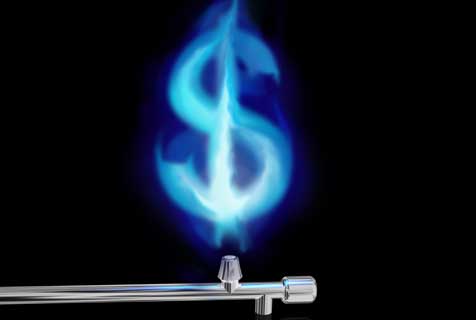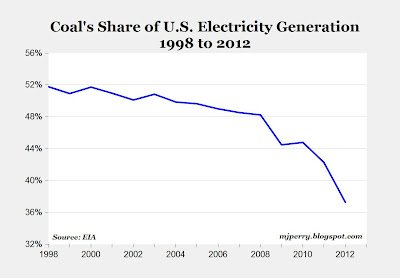Shale Gas Boom Creates Jobs and Saves Consumers Billions
Sure seems like a win, win, win situation – an energy stimulus program that didn’t require any taxpayer support and wasn’t even part of any intentional energy policy from Washington.

By Mark J. Perry at Carpe Diem

The chart above shows the significant reduction in coal’s share of total U.S. energy generation, especially over the last four years, based on the most recent EIA data through February 2012. For the first time in recent history, coal’s share of electricity generation fell to below 40% in November and December of last year, and it’s fallen even further to around 37% in the first two months of this year. That’s a very significant decline of almost 10% from coal’s 48% share of electricity as recently as 2008, and that decline has happened for just one reason. No, it wasn’t government regulation or energy policy. It was because of the shale revolution that has produced an abundant supply of natural gas at historically-low prices, providing electric utilities with a cheaper and cleaner substitute for coal.
From the Financial Times:
“The shale gas boom in the U.S. has led to a big drop in carbon emissions, as power generators switch from coal to cheap gas. According to the International Energy Agency, U.S. energy-related emissions of carbon dioxide, the main greenhouse gas, fell by 450m tons over the past five years – the largest drop among all countries surveyed.
Fatih Birol, IEA chief economist, attributed the fall to improvements in fuel efficiency in the transport sector and a “major shift” from coal to gas in the power sector. “This is a success story based on a combination of policy and technology – policy driving greater efficiency and technology making shale gas production viable,” Mr Birol told the Financial Times.
Gas is fast becoming the new fuel of choice for the US power sector: in the past 12 months, coal generation has slumped by 19 per cent while gas generation has increased by 38 per cent, according to U.S. Department of Energy figures. A gas-fired plant produces half the CO2 emissions of a coal-fired one.”
MP: So let’s sum up some of the many economic and environmental benefits of the shale gas revolution:
1. Residential, commercial, industrial and electricity-generating customers of natural gas have saved $250 billion over the last three years because of abundant, low-cost gas.
2. Hundreds of thousands of jobs have been created in natural-gas related industries, both directly in the gas drilling activities, and indirectly in the industries supporting natural gas drilling like companies producing steel piping, drilling equipment, fracking sand, etc.
3. Cheap, abundant natural gas has sparked a manufacturing renaissance in energy-intensive industries like chemicals, fertilizers, and steel.
4. In the process of creating thousands of jobs and saving natural gas customers billions of dollars, the shale revolution has also significantly reduced carbon emissions as electricity producers have switched from dirty coal to clean, cheap natural gas.
Sure seems like a win, win, win situation – an energy stimulus program that didn’t require any taxpayer support and wasn’t even part of any intentional energy policy from Washington. As Scott Grannis pointed out on his blog, “We have only just begun to see the impact of this incredible development on the U.S. economy’s ability to grow.” And at his talk tonight at the Heritage Foundation for the Prosperity Caucus, Tyler Cowen suggested that we have probably under-estimated the positive effects of the energy revolution on the U.S. economy. The changing energy landscape will definitely continue to provide significant benefits to the U.S. economy for decades to come. Welcome the Shale Revolution.
Animation of Energy Prosperity Spreading Across Pennsylvania As Horizontal Drilling Takes Off:
“Between 2009 and 2011, Pennsylvania’s natural gas production more than quadrupled due to expanded horizontal drilling combined with hydraulic fracturing (see chart below). This drilling activity, which is concentrated in shale formations that cover a broad swath of the state, mirrors trends seen in the Barnett shale formation in Texas.

Historically, natural gas exploration and development activity in Pennsylvania was relatively steady, with operators drilling a few thousand conventional (vertical) wells annually. Prior to 2009, these wells produced about 400 to 500 million cubic feet per day of natural gas. With the shift to and increase in horizontal wells, however, Pennsylvania’s natural gas production more than quadrupled since 2009, averaging nearly 3.5 billion cubic feet per day in 2011 (see chart above).”
MP: The chart below shows the monthly number of “shovel-ready” energy-related jobs in Pennsylvania, which have almost doubled from 20,000 in early 2006 to almost 40,000 this year in April. With each new shale gas well comes more than 100 new “shovel-ready” jobs as the graph clearly illustrates. Drill, drill, drill = jobs, jobs, jobs.
Help Make A Difference By Sharing These Articles On Facebook, Twitter And Elsewhere:
